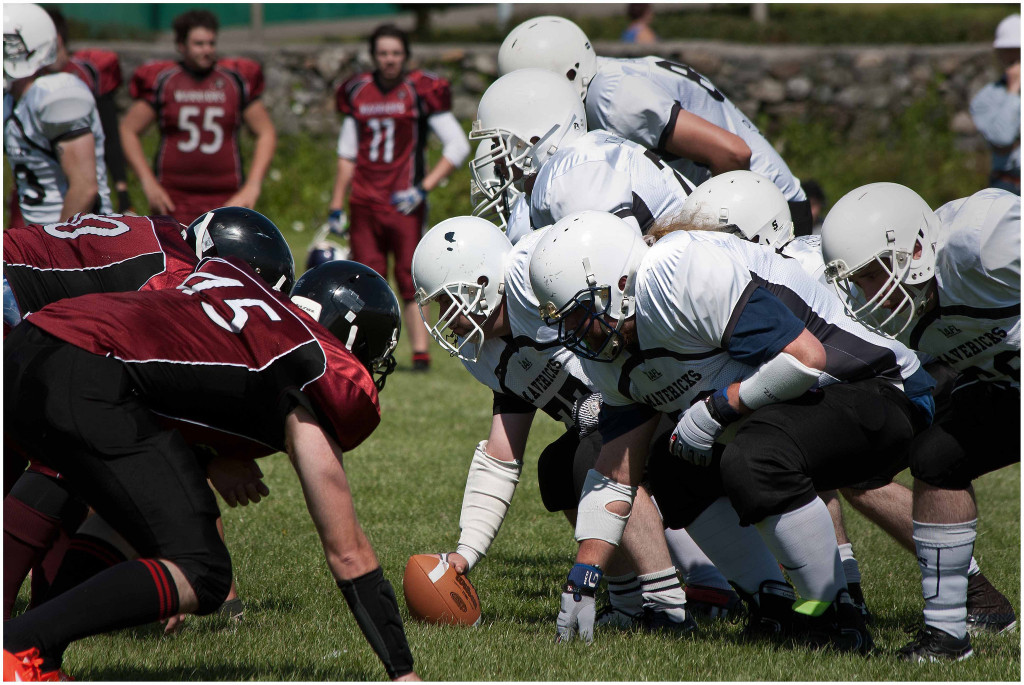
Image by Eoin Gardiner via flickr (CC BY)
Records aside, noise allows football fans to participate in the game. Their shouts and screams can give the home team a competitive advantage. They can become the so-called “12th Man.” Some teams have even gone so far as to use the PA system to pump artificial crowd noise into the stadium in search of an edge.[2]
It all comes down to timing. The home crowd becomes loudest when the visiting offense is on the field, with the goal of making it impossible for them to communicate. If the players cannot even hear the snap count —the series of commands the quarterback calls out to indicate when the center should snap the ball— it puts the team at a huge disadvantage. When the offense cannot hear the snap count, they don’t know when to drive off the line. Instead, they are left to react when the defensive players come charging at them. While they could turn their heads to watch for when the ball is snapped, that would just further disadvantage them. By the time they turned their head back to the defense they would have already been beaten.
Crowd noise is a relatively recent problem in professional football, one that grew with the increased popularity of the NFL through the 1970s and 1980s. Teams struggled to deal with the increasing volume. Mark Bowden, in a wonderful story for Sports Illustrated, outlines a number of technical solutions that were investigated but which ultimately proved ineffectual:
Players, coaches and NFL officials tried all sorts of remedies—to no avail. Rules permitted only the quarterback to communicate by radio with the sideline, but the league tried outfitting offensive guards with speakers in their shoulder pads to broadcast the snap count to the tackles. Didn’t work. They tried fitting tackles with hearing aids designed to filter out background noise. Didn’t work. They tried having the center bark out the count. Didn’t work. They tried amplifying the snap count with speakers at the 30-yard lines on both sides of the field. Didn’t work. They tried having the linemen hold hands. Didn’t work.[3]
The solution that emerged was the so-called silent snap. The process is elegantly simple; it all comes down to timing. The quarterback signals the center when he is ready for the ball —perhaps by raising his foot or tapping the center on butt— and the center raises his head. The other offensive players have been watching him and, when his head comes up, everyone begins counting off seconds in their heads. When the predetermined number of beats is reached, everyone on the offense is ready to react as the ball is snapped.
What is interesting is that the man credited with bringing the silent snap to the NFL, Howard Mudd, did not invent it. He recalled a discussion with a former colleague, Andy MacDonald, who had once coached the football team at a Michigan school for the deaf. When Mudd had asked how the team had coordinated an offensive line that could not hear a snap count, MacDonald had explained how the players had relied on timing. Mudd’s genius, in addition to the persistence required to get the silent snap adopted, was in recognizing how one group’s creative solution could be applied in another context.
Engineers are predisposed to technical solutions, particularly ones they develop themselves. However, one lesson of the silent snap is that sometimes non-technical solutions prove superior. Silent counting achieved something that sound-filtering hearing aids, speakers, and other audio equipment could not. A second lesson is the importance of recognizing that someone may have already developed a clever solution to the problem we face. And we can deploy that solution too, if we are just willing to ask the right questions.
Notes
- ^ Guinness World Records. Loudest crowd roar at a sports stadium. <http://www.guinnessworldrecords.com/world-records/loudest-crowd-roar-at-a-sports-stadium>
- ^ SI Wire. NFL takes draft pick from Falcons over fake crowd noise. Sports Illustrated, Mar 30, 2015. <http://www.si.com/nfl/2015/03/30/atlanta-falcons-fake-crowd-noise-punishment>
- ^ Bowden M. The silent treatment. Sports Illustrated, Sept. 2, 2013. <http://www.si.com/vault/2013/09/02/106363505/the-silent-treatment>
